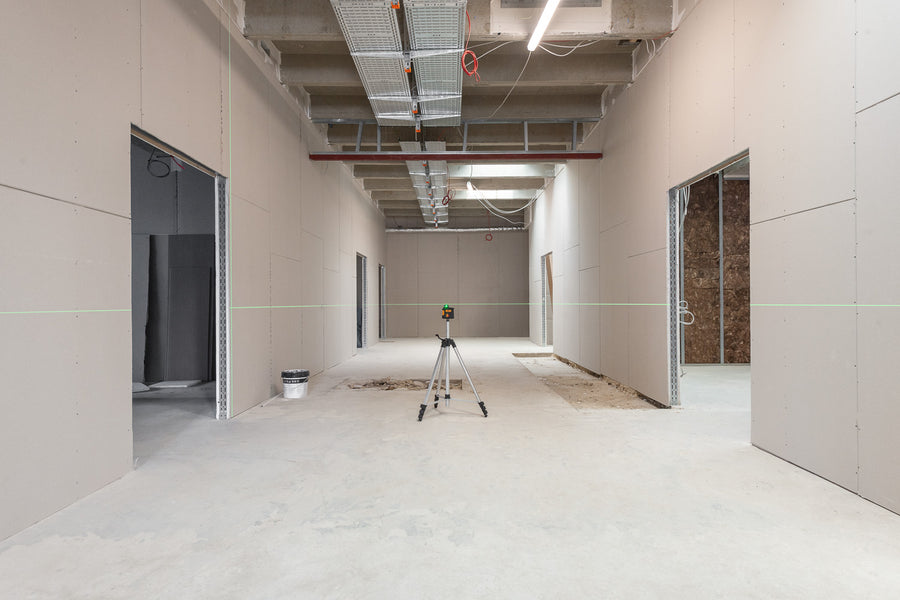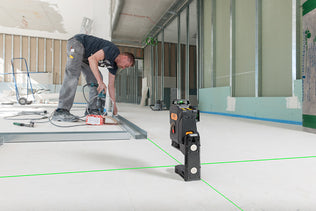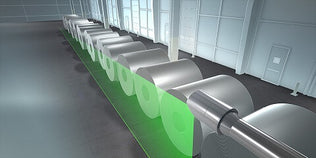Laser Levels
- What is a Laser Level?
- Types of Laser Levels
- Factors to Consider When Choosing a Laser Level
- Applications of Different Types of Laser Levels
What are Laser Levels?
A laser level tool is a control tool used in surveying and construction industries. They work by projecting a fixed single beam or multiple beams of light directly onto a working surface. When purchasing a laser level, it is important to consider a few factors including; what type of laser level it is, what application you are using the laser level for, and the beam colour.
Types of Laser Levels
Line Laser
Line lasers project a level line in one direction along your work surface. The beam tends to be very bright, steady and easy to see. Line lasers are perfect when you are leveling horizontally or vertically and are best used for indoor applications. These lasers are quite lightweight so they tend to be handheld or fixed onto a platform or mount when they are used.
Line lasers are the most common type of laser level tool, but they come in a variety of forms including; cross and multiline. They can be used for both indoor and outdoor applications with the most frequent uses including;
Indoor
- Leveling Floors
- Easily checking the height of doors and windows
- Aligning shelves, cabinets and trims
- Measuring distances between objects
Outdoor
- Basic surveying
- Site layout
- Checking elevation/level of land
- Underground services like plumbing, tunnelling, pipe layout
Cross Laser
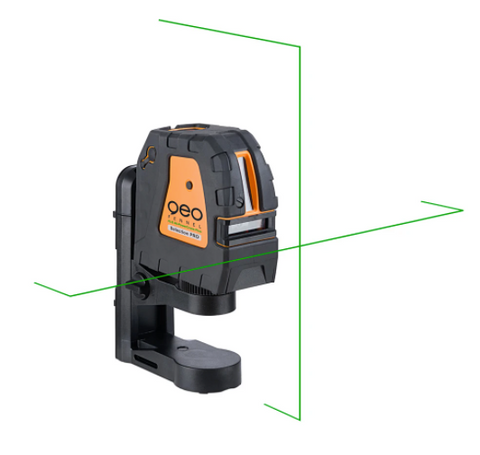
Image credit: geo-FENNEL
Cross lasers are one of the most popular type of line lasers. Like the name suggests, cross lasers work by forming a cross with a horizontal and vertical beam directly onto your work surface. Cross lasers either contain both a horizontal and vertical beam, or just a horizontal beam so it is up to you to decide whether you require both axis.
Cross lasers are excellent all kinds of basic indoor and outdoor leveling and plumbing tasks.
Multiline Laser
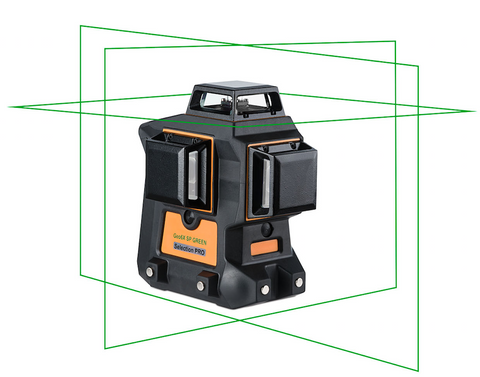
Image credit: geo-FENNEL
Multiline lasers are a type of line laser. Similarly to a cross laser, it can contain both a horizontal and vertical beams or just horizontal beams.
The difference between a cross and multiline laser is that a multiline laser contains more than three beams and can form multiple crosses from the plumb-up point, while a cross laser has only two beams.
Multiline lasers are perfect for any interior trade and projects that require measurements of right angles such as; setting walls and installing a deck.
Dot/Point Laser

Image credit: geo-FENNEL
Dot/Point lasers do exactly what their name suggests. These lasers project a ‘dot’ as a reference point on work surfaces such as walls or ceilings. Dot/point lasers are best for trades such as plumbing and electrical work such as; measuring the distance between fixtures and installing lights.
Rotary Laser Level - best rotary laser level australia

Image credit: geo-FENNEL
Rotary lasers create a single horizontal level line around an entire space in 360 degrees. Unlike a line laser which projects a steady beam, a rotary laser works by taking a laser dot and spinning it to create the appearance of a solid line. Rotary lasers are best suited to outdoor applications since the single laser dot beam can be projected farther and create a greater range for you to work with.
Rotary laser levels are suitable for applications that require you to work from long distances and require accurate leveling. These applications can include; leveling a construction site, installation of a pool and drop-ceilings.
Grade Lasers
Grade lasers/slope lasers are a type of rotary laser level that are normally used for projects that require a precise grade. These types of lasers can carry out a variety of tasks and are good for large outdoor projects. Some of these tasks that are best for a grade laser include; laying out a construction site, collecting height and angle data, aligning concrete, earthworks and excavation.
It is important to consider the two different types of grade laser when making a purchase. These types are single and dual.
A single grade laser only provides slope information for a single axis, whereas a dual grade laser allows you to read the information of two slopes on separate axises at the same time, which can create a ‘compound’ grade.
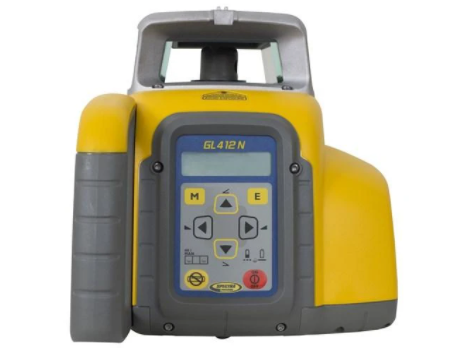
Spectra Precision GL612N Single Grade Rotating Laser
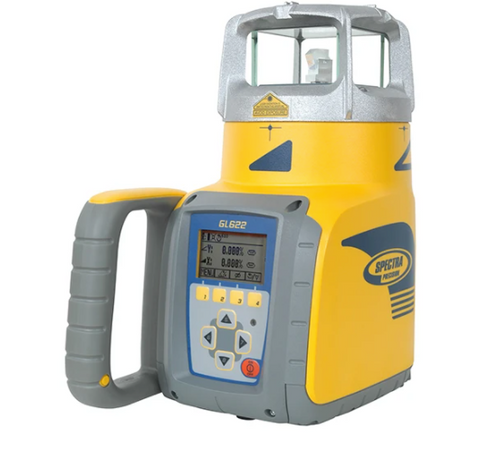
Spectra Precision GL622N Dual Grade Rotating Laser
Pipe Lasers
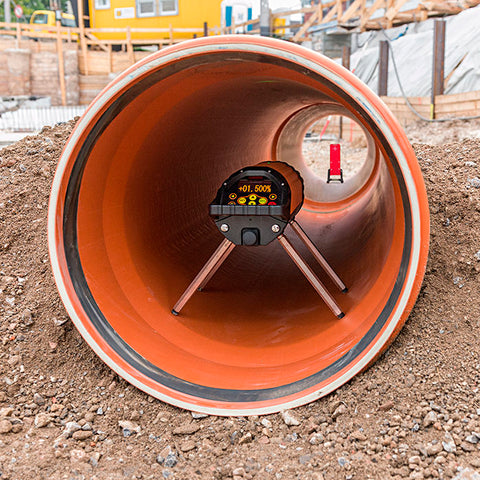
Image credit: GEO-Laser
Pipe lasers are another type of grade laser and are essential tools for underground trenching and pipe work.
Pipe lasers work by maintaining a constant rate of fall when manholes are set and the pipe is laid between the manholes. Pipe lasers are excellent tools for ensuring that a high degree of accuracy is provided for measuring the grade and slope when pipes are aligned.
Factors to Consider When Purchasing a Laser Level
Green Beam vs. Red Beam
Beam colour is important to think about when purchasing a laser level. Green beams are typically easier to see because they are brighter. When working on large-scale indoor projects where the laser line needs to be clearly seen, we would recommend purchasing a green beam laser.
The benefit of using a red beam for outdoor applications is that there is no need for you to pay extra on a green beam as it won’t be visible outdoors. Also, heavy duty machinery used in outdoor applications have accessories that typically only receive red beam lasers.
Manual Leveling vs. Self-Leveling/Automatic Leveling
Manual leveling laser require the user to manually level them through the adjustment of foot screws and spirit levels (bubble vials). Typically, manual leveling lasers give a less accurate reading and only a ‘rough’ idea of measurements to be used.
Self-leveling work through the use of an internal pendulum, while automatic leveling lasers work through an electronic servo motors. Automatic leveling lasers tend to continuously level themselves as needed.
Fixed vs. Variable RPM
Fixed vs. Variable RPM applies to only rotary laser levels. A faster RPM means the laser has a greater range but the beam projected is dimmer and more difficult to see. A slower RPM means a lesser range but the beam is brighter and easier to see. If you are working outdoors, a rotary laser with a faster RPM would be the the most appropriate for your project.
Accuracy
Laser levels are far more accurate measuring and control tools say compared to a spirit level or traditional measuring tape. How accurate you want your laser level to be depends on how you use the laser and what job it will be for.
Receivers
Laser receivers are an essential part of working with laser levels. When you cannot rely on the visibility of the laser beam (especially outdoors) a laser receiver works to find the beam and inform you of the laser’s position.
There are a few things to consider when it comes to laser receivers. Firstly, not all laser receivers work for all laser levels. Line lasers must have a pulse mode for a line laser receiver to track the beam. Secondly, line laser levels will not pick up the beam of rotating laser levels and rotating laser receivers will not pick up the beam of line laser levels. It is also important to consider the beam colour.
Red and green lasers operate at different frequencies, so you must use a specific laser receiver for different beam colours.






